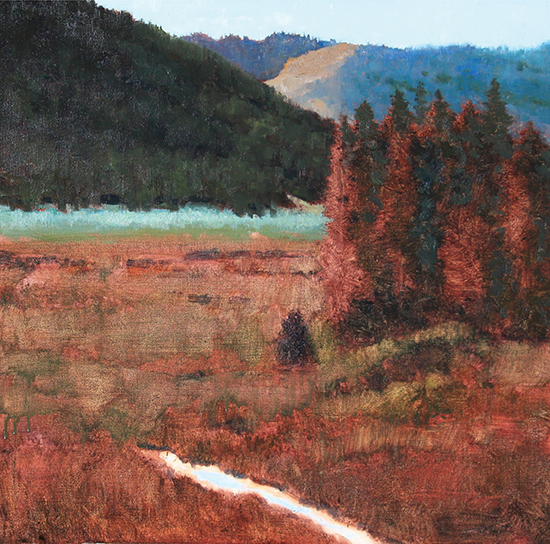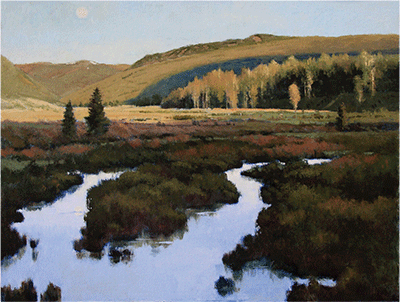
I love to work in a series of paintings rather than on an individual piece at a time. For example, I might paint a particular landscape in a number of different keys or values, different seasons, the same format or even the same subject matter in differing palettes. Working like this helps me explore a subject or process to develop a unique and emotional composition. I am orchestrating and composing rather than just painting what I see.
Much like high or low notes on a piano, I can compose or “key” my painting with a chord of values. Here we will create a dramatic work by using a limited scale of low values to create a low-key painting.
24" × 24" (61cm × 61cm) linen on medium density fiberboard
Cadmium Yellow Deep, Cerulean Blue, Cobalt Blue, Naples Yellow Light, Olive Green, Quinacridone Burnt Orange, Quinacridone Gold, Quinacridone Rose, Raw Sienna, Raw Umber Violet, Sap Green, Transparent Red Oxide, Ultramarine Blue, Utrecht White, Yellow Ochre
1⁄4-inch (6mm), 1⁄2-inch (13mm) and 3⁄4-inch (19mm) flats
1-inch (25m) flat with very well-worn frayed ends
1⁄4-inch (6mm) filbert
Sable brush
Alkyd medium, cotton swabs, palette knives, paper towels

Using a 1-inch (25mm) flat, start with an initial value pattern sketch using the ground color. Pick the ground color by deciding the final overall hue, value, temperature and mood that you have in mind. With this low-key painting, I wanted a beautiful orange-red to show through the painting in the darks, giving the painting resonance and a quiet activity. Develop the value patterns very early on by wiping out the lights with a stiffer synthetic 1⁄2-inch (13mm) flat for lifting, along with cotton swabs and paper towels.
Use transparent pigments as much as possible and a little alkyd medium that will start tacking up quickly. Keep the value patterns between three to five shapes and values.

After the paint begins to tack up, go back in with the 1-inch (25mm) flat and re-establish the darks. Dark colors should almost always be the opposite temperature of the light. Use the transparent hues that will show through in areas of the mass, creating a vibration of color. This will simplify and connect the masses for a better composition. I love to start establishing my sky values and hue at this point as well. Establish the lightest lights and the “almost” darkest darks early on so you can judge the value ranges.

Shanna’s works reflect her spirit. An acclaimed contemporary landscape painter, Shanna is always looking to stretch herself and grow as a dedicated artist.
She is equally comfortable out in the field painting alongside some of today’s most popular artists, or in the quiet of her Ogden, Utah, studio where she orchestrates her insightful works.
Shanna’s paintings are a conscious play of mood, light and color that is rooted in her love of the diverse western American landscape. Shanna has a special fondness for trees. In fact, trees are seen in the majority of her paintings. She once told me, “Trees are my people.”
For over a decade, Shanna and I have been close, personal friends. At art events, we are often mistaken for sisters, or even each other! I have shared many art shows and gallery exhibitions with Shanna, more than any other artist. Shanna and I have a supportive personal and professional relationship and always celebrate each other’s successes.
Although she lives a state away, we stay connected. We often paint together and critique each other’s work via Skype and keep in touch on Facebook.

At this stage, develop the local color with a palette knife and a stiff flat. The knife helps get more paint onto the canvas and creates nice edges. Key the painting by starting with the mid-value of the darkest mass. In each area of local color make slight temperature shifts, some cooler and some warmer. Keep some ground showing through.
Also establish the focal point of the painting. In this case, the turquoise of the backfield was what I fell in love with, as well as the strong evening light in the stream. Make a turquoise mixture of Cerulean Blue and a touch of Sap Green and Utrecht White, and lay it down more saturated and bolder in the beginning, knowing that you will temper later.

Shanna Kunz followed the same techniques from her low-key demo to create Moonrise. However, notice how in this painting the mountains are bathed in light. Shanna enjoys skipping her paintbrush across the weave of the linen to create texture.
Moonrise
Shanna Kunz
Oil on linen
30" × 40" (76cm × 102cm)

With a sable brush, work the local color in the final masses to incorporate color temperature shifts, subtle value shifts and accents to develop the space and lead the eye through the painting. The center of interest remains bolder than the other masses.
Use thin transparent glazes (I use alkyd medium) to push and pull the masses and relationships. More detail goes in to create rhythm and direction.
At this point, do more observing than painting. Temper places that demand too much attention, put more glazes in places that need emphasis and add detail with a small bristle brush. A little goes a long way! The soft light on the pine trunks gives a beautiful stop to direct the viewer’s eye to the sage blue field. I needed to illuminate the field more below the turquoise for the space to make sense. Put some lighter values in the largest shape of pines to give shape and dimension to the large mass and pull the eye up to the back mountain cliffs.
Notice how the dominant values stay in the low-key range with select contrast at the higher end. Evening Ride is moody and gives back the memory of my evening drive, just what I was looking for!
Evening Ride
Shanna Kunz
Oil on linen
24" × 24" (61cm × 61cm)
Wherever you go, when anyone shows an interest in your work, get an email address by having them sign a guest book or have a database on your website. Add them to your newsletters, blog entries and special invitations. A person can sustain a career with collectors from the past. Give them the respect and attention they deserve for their support!